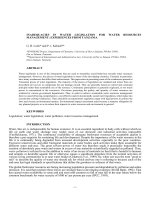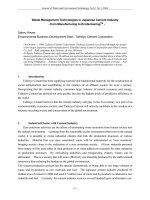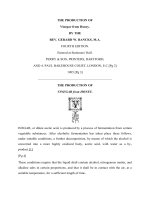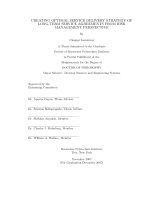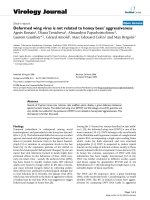Backyard farming keeping honey bees from hive management
Bạn đang xem bản rút gọn của tài liệu. Xem và tải ngay bản đầy đủ của tài liệu tại đây (4.41 MB, 107 trang )
Hatherleigh Press is committed to preserving and protecting the natural resources of the earth. Environmentally
responsible and sustainable practices are embraced within the company’s mission statement.
Visit us at www.hatherleighpress.com.
Backyard Farming: Keeping Honey Bees
Text copyright © 2013 Hatherleigh Press
Library of Congress Cataloging-in-Publication Data is available upon request.
eISBN: 978-1-57826-453-7
All rights reserved. No part of this book may be reproduced, stored in a retrieval system, or transmitted, in any form or by
any means, electronic or otherwise, without written permission from the publisher.
Cover Design by DC DESIGN
Interior Design by Nick Macagnone
v3.1
Cover
Title Page
Copyright
Introduction
Chapter 1: A Short History of the Bee and Its Magic
Chapter 2: What Distinguishes a Honeybee?
Chapter 3: Hierarchy of Bees
Chapter 4: Ease of Keeping
Chapter 5: Equipment
Chapter 6: Hives
Chapter 7: Pollination
Chapter 8: Honey and Wax Harvest
Chapter 9: Honey and Wax Uses and Storage
Chapter 10: Diseases and Dangers
Chapter 11: A Year in Beekeeping
Chapter 12: Bees, Honey, and Allergies
Chapter 13: Colony Collapse
Final Notes
Fun Facts
Recipes
Resources
The world of beekeeping is one full of mystery and intrigue for the common man. As
they watch the beekeeper, carefully moving among their hives in their full protective
suits, gathering honey from the unique little insects that make it, many people wonder
what it must be like to keep bees themselves.
Also, now, with issues like colony collapse posing a major survival problem to the
honeybee’s world, more and more backyard farmers and homesteaders are becoming
interested in beekeeping. Yet how do you know if beekeeping is really for you?
Adding hives and honeybees to your backyard farm requires a little more time, e ort,
and investment than planting a garden or raising chickens. Local restrictions and space
requirements are even more important to consider. By deciding to keep honeybees, you
are making a decision to install and maintain a small world run by your bees and
watched over by you. If done correctly, however, keeping bees can be an enjoyable and
incredibly rewarding experience.
Along with helpful hints and expert tips, this book touches on the basics of
beekeeping: from obtaining bees and what the di erent varieties available to new
beekeepers are to choosing the right environment for producing the right types of
honey. In clear, easy-to-understand language, this book helps to teach you what to
expect as a beekeeper, the pros and cons of the trade, and how the ways in which the
bees are kept affect almost every stage of their lives.
Backyard Farming: Keeping Honey Bees will be an excellent go-to source for those who
may be considering obtaining their own hives, but are not quite sure whether it is for
them. With this book written with these excited new beekeepers in mind, even the most
novice readers will find themselves ready to add beekeeping to their backyard farms.
Backyard Farming: Keeping Honey Bees is meant to be a source for those who are
considering a start in the world of bees. Laying out the basics simply and clearly without
a lot of complicated, in-depth information, it will give potential new beekeepers an idea
of what they can expect when (or if) they decide to have a hive of their own or if it is a
hobby or potential business that they even want to continue to pursue.
So sit back with your favorite beverage (perhaps with a little honey?) and begin your
adventure with honeybees, honey, and all the magic that beekeepers cherish about their
little charges.
Kim Pezza grew up among orchards and dairy and beef farms having lived most of her
life in the Finger Lakes region of New York State. She has raised pigs, poultry and game
birds, rabbits and goats, and is experienced in growing herbs and vegetables. In her
spare time, Kim also teaches workshops in a variety of areas, from art and simple
computers for seniors, to making herb butter, oils, and vinegars. She continues to learn
new techniques and skills and is currently looking to turn her grandparents’ 1800s farm
into a small, working homestead.
I
t is a good bet that there are probably only a few people in the United States—or
anywhere else for that matter—who have never seen a honeybee at least once in
their lives. It is also well known how important these busy, buzzy little girls (yes,
girls, but we’ll cover that later) are to our own food supply. It has even entered the
public consciousness that honeybees are now facing peril on a worldwide scale.
However, what isn’t well known is just how long and storied a history the honeybee has,
dating back millions of years (around 60 million years in fact).
There is even evidence to suggest that a bee species native to North America lived
approximately 14 million years ago, its existence proven through a worker-bee fossil
found in Nevada in 2009. Unfortunately, those bees died out long ago, and the
honeybee did not reappear on the North American continent again until about 1622,
when European settlers brought their hives with them. Like many other species of
wildlife that originated with the European settlers, it is thought that some bees left their
captivity and set up shop in the untamed wilderness of North America.
Yet it isn’t just prehistoric North America that has played host to honeybees. A 19
million-year-old giant honeybee fossil was found on Iki Island, Japan, and there is
evidence of beekeeping going as far back as ancient Egypt, Greece, and Spain. Some of
this evidence even includes excavations of preserved hives. In fact, the Egyptian Papyrus
Ebers, the oldest known book of medicine, includes a number of recipes that utilize
honey for its curative effects.
Despite being one of the oldest agricultural practices known to man, beekeeping
continues to nd popularity today, not only in rural elds, farms, and backyards, but in
the urban landscape as well. Small city lots, suburban backyards, and building rooftops
have all become home to hives, not only in the United States, but in other areas of the
world as well. Ironically, as enthusiasm for bees and beekeeping continues to grow, the
world’s bee population continues to shrink. The decline of the honeybee population in
the United States alone has resulted in a 50 percent decrease over the last fty years.
People are not only becoming involved in the plight of the honeybee and what humans
stand to lose with the loss of the bees, but are getting involved with beekeeping
themselves. By learning to keep bees, you are joining a proud tradition, which has
existed and thrived for thousands of years, at one of the most important times in its
history.
A
bee is a bee, and all bees basically look alike, act alike, live alike, and make the
same honey the same way for harvesting, right?
Wrong.
In general, there are over 20,000 species of bees in existence. Scienti cally, the
honeybee species is that of Apis. The class is Insecta, the order is Hymenoptera, and the
family is Apidae. However, out of all of those, only seven species are recognized as
honeybees.
They are:
• Apis mellifera (Western)
• Apis nigrocincta
• Apis koschevnikovi
• Apis cerana (Eastern Asiatic)
• Apis andreniformig (Black Dwarf)
• Apis dorsata (Giant Honeybee)
• Apis florea (Red Dwarf)
Along with the recognized species, there are 44 subspecies.
Common Bees in the United States
Although there are no longer any species of honeybee that are native to North America,
there are six types of bees, imported throughout the decades (if not centuries), that are
most commonly available in the United States.
They are (in no particular order of popularity):
• Italian Bee
• Italian Bee
• German Bee
• Carniolan Bee
• Caucasian Bee
• Buckfast Bee
• Russian Bee
A quick review of each of the six types of common honeybees in the United States is as
follows:
Italian Bee: The Italian bee was rst imported to the United States in 1859. For the
beekeeper, the Italian bee has a gentle temperament, which makes handling it much
easier. They are excellent honey producers, and their tendency to swarm is quite low,
meaning that it is less likely that a keeper will have his bees leaving the hive in search
of a new home. (The full story on swarming and why bees do it will be discussed later in
Chapter 6.)
An Italian worker bee. Photo courtesy of Wikimedia Commons.
German Bee: Also known as the European Dark, the German bee is hardy in winter, a
good ier in the cold, and is, therefore, a great choice for cold climates. Like the Italian
bee, they have low swarm tendencies. The worker and queen can have good longevity if
cared for properly. It should be noted, however, that hybrids/crossbreeds of the German
bee may have aggressive tendencies, which could make handling the bees more di cult
for the beekeeper.
Carniolan Bee: The Carniolan is a subspecies of the Western honeybee (Apis mellifera).
Although this species is prone to swarming, can have problems in the heat, and the
queen may be di cult to locate within the hive, the Carniolan is still a favorite due to
the fact that, although it will defend itself against other insects and insect intruders, it
remains gentle to its handlers—even the queen remains gentle.
The Carniolan bee is also resistant to (at least some) diseases and parasites. They can
be kept in populated areas (great for urban beekeepers), and adapt quickly to changes
in the environment. They also do well in regions with long winters.
A Carniolan bee. Photo courtesy of Wikimedia Commons.
Caucasian Bee: Also a subspecies of the Western honeybee, the Caucasian is a gentle
and calm bee, with strong colonies. However, they are not a good choice for those
keepers in northern climates, as they do not winter well. The Caucasian may also drift
away from a hive entered by a robber bee. (Robber bees will be covered later in Chapter
10, but it is almost exactly what it sounds like: a bee that steals from other hives.)
Buckfast Bee: The Buckfast bee is a crossbreed (in anything that I have found, it just
states that this breed is a cross of many breeds, but, so far, nothing speci c) that takes
its name from Buckfast Abbey in Devon, the United Kingdom, from whence it
originated. It is popular among beekeepers due to the fact that they are gentle, good
tempered, and calm, with low sting tendencies. They have a keen sense of smell, are
hardy in the winter, and are good honey producers.
A Buckfast bee. Photo courtesy of Marc Andrighetti.
Russian Bee: The Russian bee originated in the Primorsky Krai region of Russia. They
were imported into the United States by the USDA Honeybee Breeding, Genetics, and
Physiology Lab in 1997. Although the species endures winters well, is resistant to some
parasite mites, and is comprised of good honey producers, the Russian bee does tend to
swarm, and its numbers tend to explode.
A Russian bee. Photo courtesy of Robert Engelhart.
Living
The honeybee is a social bee, meaning that it lives in an organized structure, working
and living in constant cooperation with others. In contrast, the solitary bee has no social
structure and will live and hunt alone.
It should be noted that it is precisely this social colony structure that allows the
honeybee to survive for years, as it has the ability to huddle and eat its honey to survive
the winter.
However, it would be inaccurate to assume that it is only the honeybee that produces
honey. Solitary bees and the bumblebee are good examples of non-honeybee honey
producers. Yet, although these bees will both produce and store honey, they do not
produce anywhere near the quantity that honeybees do, making them un t to use for
honey harvesting.
The size of the typical honeybee colony can average 60,000 residents. This will break
down into about half of the bees tending to the young and assisting the queen, while the
rest go out and forage for nectar and pollen, both being food for the bees (though the
bees will also need water). Along with the queen, you also have the worker and drone.
All workers are female and work the hive in various roles. All drones are male and are
only breeders. These roles will be covered in more detail a bit later.
Stages of the Bee
As do other insects, the honeybee goes through developmental, or life, stages. These
stages are:
• Egg
• Larval
• Pupal
• Metamorphosis into Adult Bee
Eggs and larvae in their combs. Photo courtesy of Waugsberg.
Much like the butter y, the honeybee will go through each one of these stages,
eventually becoming the functioning worker, drone, or, in some cases, new queen.
The fertilized egg of the honeybee is laid within the wax chambers, or cell, of a
honeycomb. The honeycomb that is used for laying eggs is called the brooder comb.
Looking like little grains of rice, each egg stands on and within its own small cell.
Within only three days of being laid, the eggs will hatch, beginning the next stage of
development, which is the larval. The larva looks like a little white worm. At this stage,
the larva does not have legs or eyes.
For the rst few days, the larva will live on a diet of royal jelly, a substance rich in
protein, vitamins, fats, and minerals. Starting at day three, the larvae’s diet will be
altered, according to the roles that it will play in the hive or colony. Those destined to
be workers and drones will be switched to a honey, pollen, and water diet. Those that
have the potential to become queens will continue on an exclusive diet of royal jelly.
The larva will have ve moltings during this period. Be they worker, drone, or queen,
the care given to the larva by the workers is nonstop, providing it with at least ten
thousand meals.
A drone pupa. Photo courtesy of Eugene Aufnahme.
After a period of time ( ve and a half days for queen larvae, six days for worker
larvae, and six and a half days for drone larvae), they will move on to the next stage:
the pupal stage.
At the pupal stage, the larva goes through a complete body overhaul, totally changing
its structure. As tissues reorganize, the body will change into the more familiar form of
the bee. Normally this takes seven and a half days for a queen, fourteen and a half days
for a drone, and twelve days for a worker. The nal stage is the metamorphosis into the
adult bee, thus completing the cycle within a 21-day time period.
New bees emerging from their combs. Photo courtesy of Waugsberg.
Bee Anatomy
The anatomy of the adult bee is broken into three main parts:
• Head
• Thorax
• Abdomen
The Head
The head consists of the antennae, the eyes, the mandibles, and the proboscis. The eyes
consist of two compound eyes as well as three simple eyes.
The compound eyes are basically light-sensitive cells that can understand color, light,
and direction. The three simple eyes (or ocelli) are arranged in a triangle and determine
light.
Antennae are used for sense of smell through hairs that cover them and, sometimes,
are even able to gure out the direction that an odor is coming from. The antennae can
also measure ight speed, as well as information about taste, temperature, and
humidity. The antennae are also sensitive to vibration.
The parts of a bee’s head. Illustration by Ariel Delacriox Dax.
The mandibles are, in basic terms, very strong jaws. They are used for eating pollen,
cutting and shaping wax, feeding the young as well as the queen, cleaning the hive,
grooming, and fighting.
The proboscis is the tubular part of the mouth used for feeding. It is also referred to as
the glossa. Basically, it is like a tongue, but the bee will sip water nectar and honey
through it as we would use a straw.
The Thorax
The thorax consists of the wings, legs, and movement muscles. The wings are in two
parts: the forewing and hind wing. The forewing is the larger of the wings. It is used
mainly for ight, but can also be used with the hind wing for cooling. The hind wing is
used for ight and cooling the hive. The forewing and the hind wing may hook together
to work in unison.
There are six legs that provide movement and the ability to manipulate and carry
pollen. One set is structured to clean the antennae. Each front leg has two parts, with a
notched spot that wraps around the antennae and pulls it through the notch, removing
dust and other particulates that could interfere with the sensitivity of the antennae. This
is called the antennae cleaner.
The anatomy of a honeybee. Illustration by Ariel Delacriox Dax.
The middle leg, although not having a particular special purpose, helps to collect
pollen off of the bee’s body for deposit into the pollen basket.
Bee with filled pollen bucket. Photo courtesy of Wikimedia Commons.
The hind legs are home to the pollen baskets. The pollen basket is a small cavity
surrounded by small hairs. The pollen goes into these hairs, getting pressed in and held
in place between the small hairs. From there, the pollen goes to the pollen comb (also
located on the hind leg), where it is pressed, compacted, and then transferred to the
outside of the hind leg, where the pollen is secured by a single hair.
Each leg has a foot, and each foot a claw. The claw allows the honeybee to hold onto
rough surfaces.
The Abdomen
The abdomen is in seven segments. In segments four through seven, wax is created and
secreted. In the queen bee, the abdomen also contains the female reproduction organs,
and, in the drone, the male reproduction organs.
The stinger is also found in the abdomen. The workers and the queen have stingers,
which they use for defense; however, once a worker bee stings, it will die. This is due to
the fact that, once the stinger, which is barbed, tries to pull away, the abdomen
ruptures, causing the death of the bee.
Now that some of the basics have been discussed about the honeybee, let us explore a
bit further as to some of the things that a potential beekeeper needs to know as you
consider your future with the honeybee.
A Few More Facts on the Honeybee
As insects go, the honeybee is an interesting one, and one that has lots more little
secrets surrounding them. Besides what has already been discussed, a few more
tidbits of information are worth noting, if for no other reason than to show more of
what these little powerhouses have behind them.
If you have ever seen a honeybee y, you may have noticed that the wings are
going so fast that you can hardly see them. This is because the honeybee’s wings
beat over eleven thousand times per minute. Also, that “buzz” that you hear is due
to the flap of its wings.
While we are discussing wings, the honeybee ies at an average speed of
between 12 and 15 miles per hour, usually keeping within a one to ve-mile radius
of its hive. (The closer the bee can stay to the hive, the better it likes it.)
Honeybees perform best between temperatures of 62°F and 105°F. However, they
will slow down in winds of 15 miles per hour, and they will stop altogether in 25
mile-per-hour winds.
Vision wise, honeybees can see every color that a human being can see, with the
exception of red, and is the only insect that produces food t for human
consumption.
L
ike all societies, honeybees have a de nite social structure. From the queen,
without whom the colony would not exist, to the drone who can be literally quite
dispensable, the honeybee has a very interesting social ladder. So, for those of you
who are not familiar with their social structure and way of life, once you have learned
more, you may never look at honeybees the same again.
The honeybee has what would be considered an actual, functioning class system,
where everyone knows its place, status, and job straight from the date it hatches. In a
working colony or hive, there can be between 50,000 and 60,000 of which 99 percent of
the hive will be female.
The three types of bees. Illustration by Ariel Delacriox Dax.
There are three “classes” within all honeybee colonies or hives:
• Queen
• Worker
• Drone
The Queen
There is only one queen in any hive or colony, and her one and only job is to produce
eggs in order to populate the colony. She is the only fertile female within the colony.
The queen is the largest bee in the colony. Her life span is up to ve years, with
approximately three of those years being productive (although some queens may need
to be replaced sooner).
On her maiden ight, the queen will leave the hive, at which time drones will fertilize
her. Although this will be her only mating, the process lasts several days, during which
she will store the sperm within her body. The drones that fertilize her may not
necessarily be from her hive or colony. She will then return to the hive, after which she
will remain indoors for the rest of her life. (The only other time that the queen may
leave is if the hive becomes overcrowded. If that happens, she may lead a swarm to a
new location.)
The queen will begin her job of populating the hive as soon as she returns. She will
average 1,000 to 1,500 eggs per day, with approximately 200,000 being laid in her
lifetime. At some point, the queen will become infertile or perhaps even sick. When this
happens, she is then replaced in a process called “supersedure.” While beekeepers may
do this themselves, it is equally viable for the colony itself to create a new queen to take
over for the old.
Yet how can a colony actually create a queen? It all begins at the larval stage. The
workers will rst create queen cups. Queen cups are larger than the regular cells/cups,
and they are vertical instead of horizontal. The existing queen will lay eggs within the
cells, just as she would in the others. Unlike the others, though, the larvae that could be
queens will be fed a diet made up entirely of royal jelly.
Royal jelly is secreted from the glands in the head of the worker bee, which, in this
case, is the nurse bee. The jelly is rich in protein, vitamins, fats, and minerals. For the
rst three days of the larva’s life, it is fed a diet strictly of royal jelly. After the third
day, only the larva that is to be queen will continue on this exclusive diet, doing so
during the entire larval stage.

